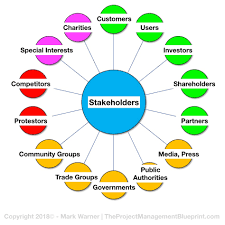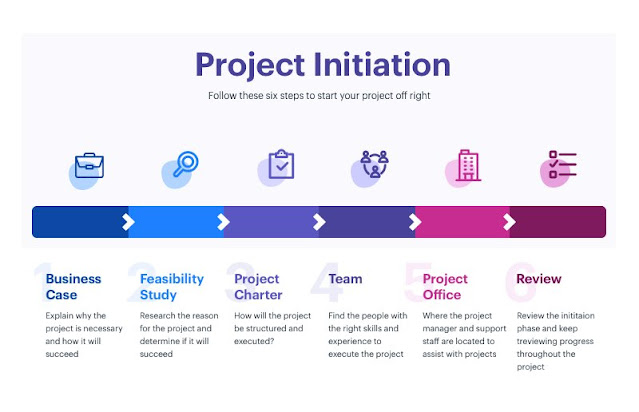Project Management Processes:
This
is the process of applying knowledge, skill, tools and techniques for the
execution and successful completion of a project to achieve some rational or
irrational, tangible or intangible objectives.
IF
we assume that we have to invest in a project providing Financial Services to a
specific group of individual or organization. So we have to pass through number
of steps and processes for this.
Project Initiation Stage:
The
first step in project management process is the initiation stage, when we are
at the beginning of a project. In this we have to perform following functions:
I. Project Charted
The document showing what actually is project all about and can be accessed by
anyone.
In this we will answer some question like, why to undergo this project?
What are our expectations from this project? Who will be our target customer? In
this we have to identify that what sources we have to accumulate either these
will be internally or externally.
How funds will be generated. The budget and
duration of the project will also be talked about and will be noted in this
document.
II. Identifying Stakeholders:
At this stage we have to identify our stakeholder
that who are the stakeholders in this project. It is to be define internal stakeholders
like investors (banks in our case), employees, management and connected
stakeholders like customer (govt. or non-govt. organizations in our case),
suppliers, competitors (banks, insurance companies, saving centers etc. in our
case), etc. and also external stakeholders like government, pressure groups
(substitute product producers), etc.
Project
Planning Stage:
Project
planning comes next to initiation stage and it is the most critical point in
time and contributes much in project success and failure.
1.
Project Management Plan:
It is consists of series of plans that guide the
project manager and its team during the execution and controlling of a project.
Project management plan covers the whole theory and guide line of the project.
One of the valuable project management plans includes the project strategies
with scope, objective and goals to achieve.
2. Project Management Planning Process:
a. Collecting requirement for project – we have to allocate our sources and resources
b. Defining Scope
– in scope we have to decide that how large our project will be?
c. Creating WBD
– In work break-down structure we will have to break our project into number of
different activities. Steps include will be,
·
Define activities
– what are our key activities to perform and what types of activities we have
to perform?
·
Define resources
for activities – We have to think out that by whom these activities will be
carried out?
·
Estimate the
duration of activities – what is the time limit for each activity.
·
Arrange or
sequence the activities – Arrangement of activities in executing order will be
made.
·
Develop schedule
for activities – We have plan that when what activity will be carried out?
d. Estimate costs
– what are costs associated with each activity and in total project:
·
Determine Budget
– In budget we have to estimate our costs and how these cost should met?
e. Quality Plan
– What quality product we are offering to customers?
f.
Planning
for HR – what kind of skill will be
need by the employee to execution of project.
g. Procurement Plan – what kind of customers we are looking for. Who will be our suppliers
of raw material and what our customer’s target group is.
h. Risk Management Plan –in this stage we have to decide how risks will be
handled.
·
Identifying Risks
- what kind of risk (internal or external) may arise.
·
Qualitative Risk
Analysis – SWOT analysis will generally help us to determine. qualitative risks
·
Quantitative Risk
Analysis – these can be found by analysis historic data, determining beta
co-efficient, variances, etc.
·
Plant risk
responses – in which a project manager determines that if certain risk appears
how it will be handled or responded
i.
Communication
Plan – In project management the
communication is multi-dimensional and project manager has to respond to
employees, customers, external stakeholders and top management. So we have to
develop proper communication channels before the execution of a project because
communication is the key to success.
Execution Stage:
After planning being
a project manger we have to execute the work as planned. But before execution we
must ensure that all before has done well and in future there will be not any
hurdle that will badly affect the project and if there will be, it could be
handled in easy way. Steps in execution may involve:
1.
Acquire
project team – that will handle or
execute the project. They can be acquired from inside the organization as well
as out side the organization. But in our case we have to find that how
experienced and non-experienced personnel will be hired.
Being a project
manager the only thing which must be ensured, is the capability of project
team, either they will better execute the project or not.
2.
Develop
Project Team – If our team has some
deficit or nature of work in our project is different from the market then we
have to provide some specific training that will help the project team to learn
the methodologies for execution of work. So, that in future there should not be
any miss-conception.
3.
Management
Project Team – During the executing we
will have to manage the project team in such a way so that each and every
activity that is planned should be executed in time and completed in time.
4.
Managing
Stakeholder’s Expectations – Here we
will have to meet the stakeholder’s expectation. In other words, we have to see
that whether our financier’s expectations are met for which he is providing us
the capital. And whether or not the potential customers are getting more and
more benefit from our services.
5.
Distributing
Information – the best way I think
to get work done from the employee is to getting them involved in decision
making and providing all the information about the project. So we will have to
ensure that our communication channels are working properly.
6.
Performing
quality assurance – At this we will
have to perform quality checking that all the quality standards are set because
it is the stage when actual work starts if there is any discrepancy this will
lead to customer dissatisfaction in the future .
Compare our work done with the
quality standards that were established at the time of planning. If there is
any kind of deficiency or otherwise, we may have take corrective action as
well.
7.
Conduct
Procurements – at this stage we will
have to make contracts and should interact with the suppliers specifying the
quality, time, price, scope, payments, place of delivery, warranty, limitation
of liability, incentives, and every thing that might affect our project either
positive or negative.
Monitoring
and Control:
At this stage we have monitor and control those things
which we are executing in this project. In our case we have to see that whether
our customers are getting maximum benefit from our project and if not so what
are the mean reasons, where is the deficiency?
How internal stakeholders are
performing their work and what are the expectations of our customers. Shortly,
we have to monitor each and every thing we have planned.
1.
Verifying
Scope – In this we will have to
ensure that whether our project is customer oriented and targeted the potential
customers.
2.
Quality
control – whether or not our
financial services are according to our customer’s needs.
3.
Performance – All the employees are working effectively and
efficiently.
4.
Risks Control – what kind of risks are actually negatively
affecting our project and what potential measure should we have to undertake.
If the risks are systematic we will have to take preemptive measures to outcome
these risks. And if the risks are un-systematic then we will have to take those
steps which synthesize our project less-affective.
5.
Control Costs – controlling the costs is to much critical because
we will not like to project be costly and on the other hands if we cut the
costs the quality standards does not met. We will also ensure that all the
activities are done within the budgetary estimates.
6.
Control Scope – We will have to does things that were discussed in
project planning and will not exceed the boundaries of our project because this
may result in delay of project and also costs and time may increase.
7.
Control
Schedules – The important thing we
will have to see that whether all the organized activities (in WBS) are done at
time with the same costs as proposed.
We will have execute all the activities at
their time because it may that these activities are linked with one another and
delay of activity may cause delay of other and so resulting in delay of the
whole project.
8.
Control
Procurements – At this stage will
have to see the performance of contract with supplier and manage the
procurement relationship and make necessary changes as needed.
We will have to ensure
that both parties are working under their limitations of liability and the
consent of both has not been negatively affected.
Final Words:
Did you know that we keep bringing you the best articles that have the best impact on your knowledge and your personal life? I am sure you will like our What is Project Stakeholders? article.
If you have any questions about this article, please let us know in the comments. We will provide a better answer. You can visit our website to see more of our great articles.
We hope you enjoy the article and enjoy it.
Thank you.
World greatest update and general discussion of the world and marketing knowledge is available on our this particular blog. If you want to learn the fastest-growing religion in the world in 2021 or the world's greatest news about politics or the latest education news then you are now in the right place. I have provided world religion news and political breaking news. as well as education news updates in the world, I know you will benefit from our RegularTopics particular website.


























